by Nick Drew | Mon 09 Sep 2019
Intelligent Machine Control Goes Large
Komatsu have been at the forefront of machine control since it launched the 21-tonne class PC210LCi-10 hydraulic excavator back in 2014 and has continued to be a market leader in excavators with factory integrated machine control systems ever since. However, the foundations for this had been laid much earlier, as Komatsu had actually been working to integrate GPS technology into its earthmoving kit with Topcon since as far back as 2004.
With its constant focus on quality, Komatsu wanted to do things differently to other manufacturers who more often than not, simply offer pre-wired set ups ready to receive whatever retro-fit system the customer decides to go for. But by offering a dedicated factory fitted system the Japanese manufacturer felt that they could offer the best accuracy, precision and quality from the installation.
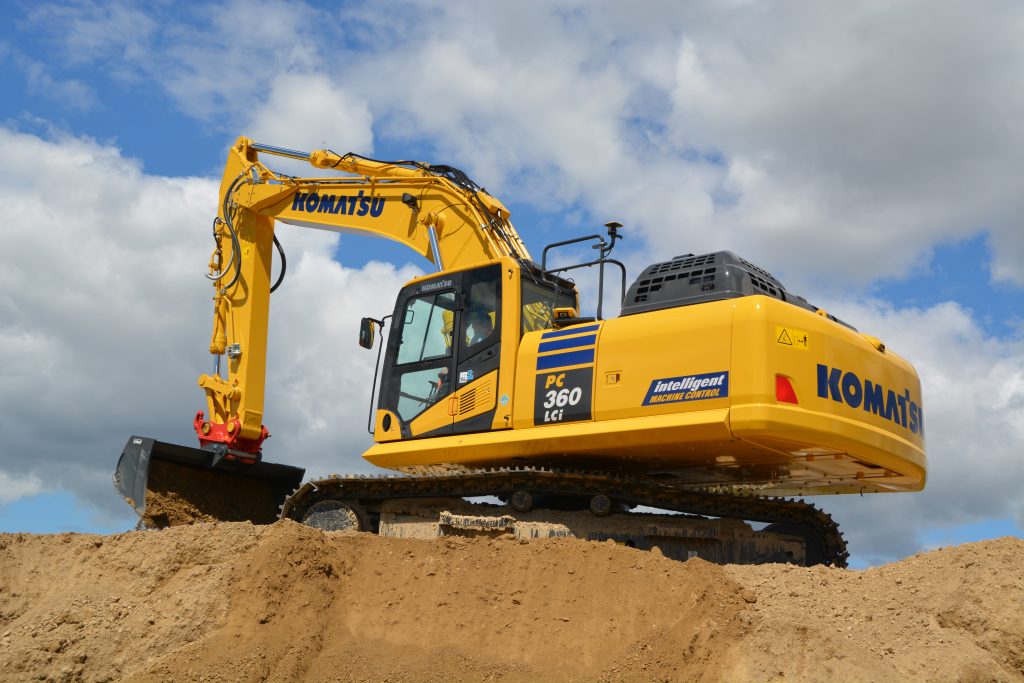 In front of a record breaking global audience at Bauma earlier this year, Komatsu revealed its latest addition to the LCi range, the 36-tonne PC360LCi-11 and according to Komatsu’s ICM (Intelligent Machine Control) Product Manager Robert Macintyre there will be more size options to come including, but not restricted to, the 30-tonne class PC290 in due course.
The PC210LCi’s have been built at Komatsu’s UK facility in Birtley for some years now, but to start with the PC360LCi’s will be produced in Japan, before manufacture of the model for the European market transfers to Birtley in 2020.
In front of a record breaking global audience at Bauma earlier this year, Komatsu revealed its latest addition to the LCi range, the 36-tonne PC360LCi-11 and according to Komatsu’s ICM (Intelligent Machine Control) Product Manager Robert Macintyre there will be more size options to come including, but not restricted to, the 30-tonne class PC290 in due course.
The PC210LCi’s have been built at Komatsu’s UK facility in Birtley for some years now, but to start with the PC360LCi’s will be produced in Japan, before manufacture of the model for the European market transfers to Birtley in 2020.
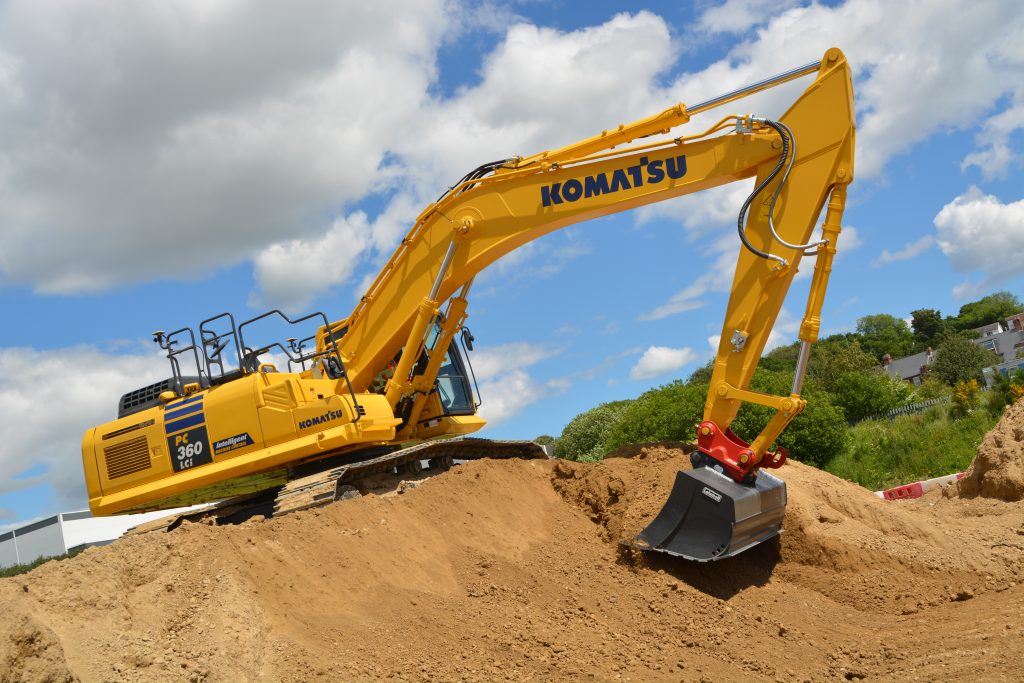 Walking around the machine externally, the PC360LCi-11 looks much the same as its conventional range brother and tipping the scales at 35,600kgs – 36,200kgs the machine is powered by the same in-house built Komatsu Tier 4/Stage IV emissions compliant 6-cylinder engine, which has a power output rating of 202kw (271hp) @2,000rpm. It’s a fair lump of an engine and I must say it sounds beautiful when purring away during operation. Maximum digging depth is only 100mm less than the standard model at 7.28m with maximum bucket capacity the same at 2.66m3.
Walking around the machine externally, the PC360LCi-11 looks much the same as its conventional range brother and tipping the scales at 35,600kgs – 36,200kgs the machine is powered by the same in-house built Komatsu Tier 4/Stage IV emissions compliant 6-cylinder engine, which has a power output rating of 202kw (271hp) @2,000rpm. It’s a fair lump of an engine and I must say it sounds beautiful when purring away during operation. Maximum digging depth is only 100mm less than the standard model at 7.28m with maximum bucket capacity the same at 2.66m3.
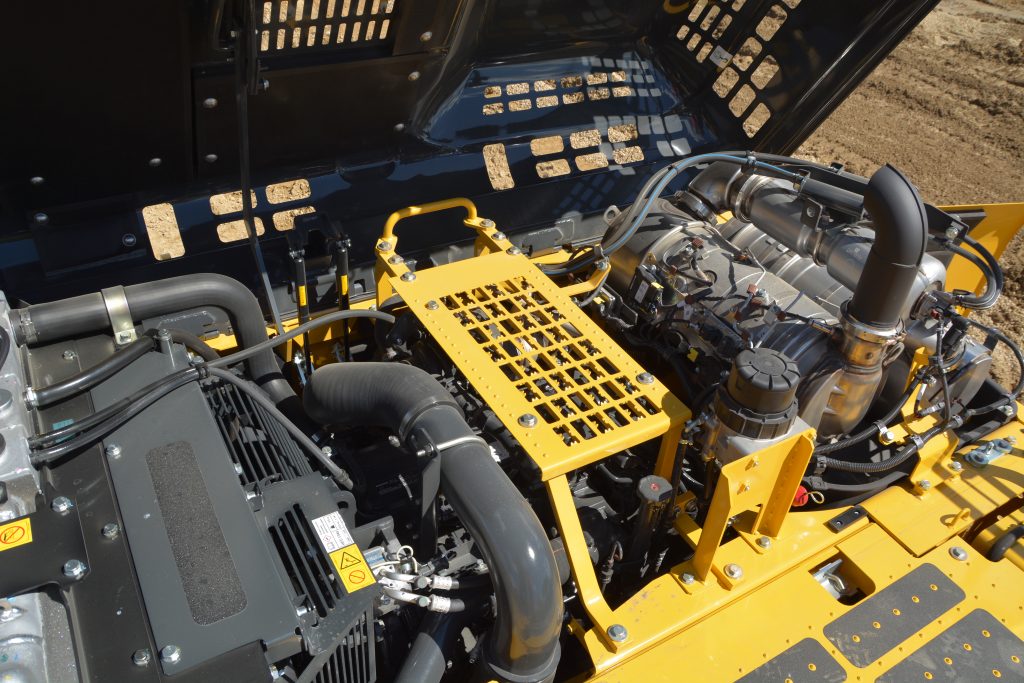 The same key components are located inside the large rear panel doors, although different to many makes, the nearside rear on the PC360LCi is home to the hydraulic pumps, while the offside rear is where we find the cooling packs. But its when you start looking in closer detail that you notice the subtle changes that separate this machine apart from a regular excavator.
The machine is equipped with a variety of clever gizmos that play their part in feeding back information to the system about where the work equipment is. The first of these components is the IMU (Inertial Measurement Unit), which is located in the base of the machine upper-structure. This device determines the machines pitch and roll using a gyro and accelerometer, which feedback the data. As I understand it and in layman’s terms, it tells the system at any point in time what angle the machine is sitting.
The same key components are located inside the large rear panel doors, although different to many makes, the nearside rear on the PC360LCi is home to the hydraulic pumps, while the offside rear is where we find the cooling packs. But its when you start looking in closer detail that you notice the subtle changes that separate this machine apart from a regular excavator.
The machine is equipped with a variety of clever gizmos that play their part in feeding back information to the system about where the work equipment is. The first of these components is the IMU (Inertial Measurement Unit), which is located in the base of the machine upper-structure. This device determines the machines pitch and roll using a gyro and accelerometer, which feedback the data. As I understand it and in layman’s terms, it tells the system at any point in time what angle the machine is sitting.
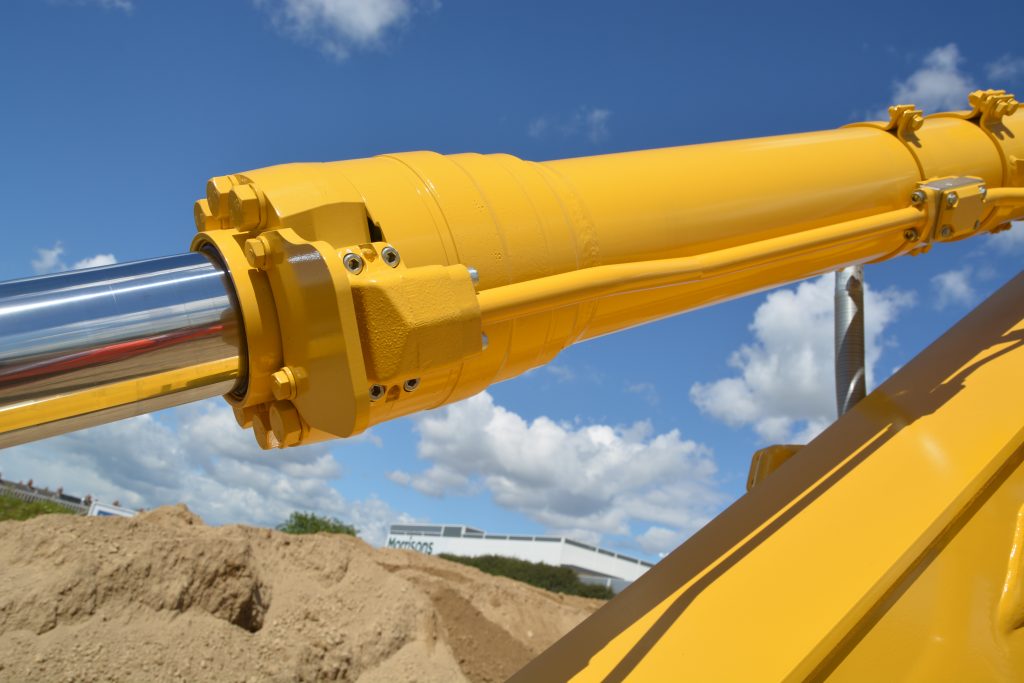 At the end of the ram cylinders you notice the housing for Komatsu’s unique stroke sensors, these are fitted on the boom, dipper and bucket cylinders and if equipped with one, on the tilt bucket cylinders. Komatsu are the only manufacturer using stroke sensors on excavators. So just what is a stroke sensor exactly I asked? Rob Macintyre explained, “The stroke sensor is a cylindrical ball bearing that rotates as the rod moves in and out, using the feedback the system can calculate where the work equipment and bucket is at any one time and the operator see’s this in real time on the in-cab monitor”.
I note two silver rods, one at the base of the boom and one up on the dipper arm, these are part of the rotary encoders, the rods connect to reset sensors, part of the control mechanism for the electronics. The devices continually reset themselves during operation to maintain that all important maximum accuracy of the system.
At the end of the ram cylinders you notice the housing for Komatsu’s unique stroke sensors, these are fitted on the boom, dipper and bucket cylinders and if equipped with one, on the tilt bucket cylinders. Komatsu are the only manufacturer using stroke sensors on excavators. So just what is a stroke sensor exactly I asked? Rob Macintyre explained, “The stroke sensor is a cylindrical ball bearing that rotates as the rod moves in and out, using the feedback the system can calculate where the work equipment and bucket is at any one time and the operator see’s this in real time on the in-cab monitor”.
I note two silver rods, one at the base of the boom and one up on the dipper arm, these are part of the rotary encoders, the rods connect to reset sensors, part of the control mechanism for the electronics. The devices continually reset themselves during operation to maintain that all important maximum accuracy of the system.
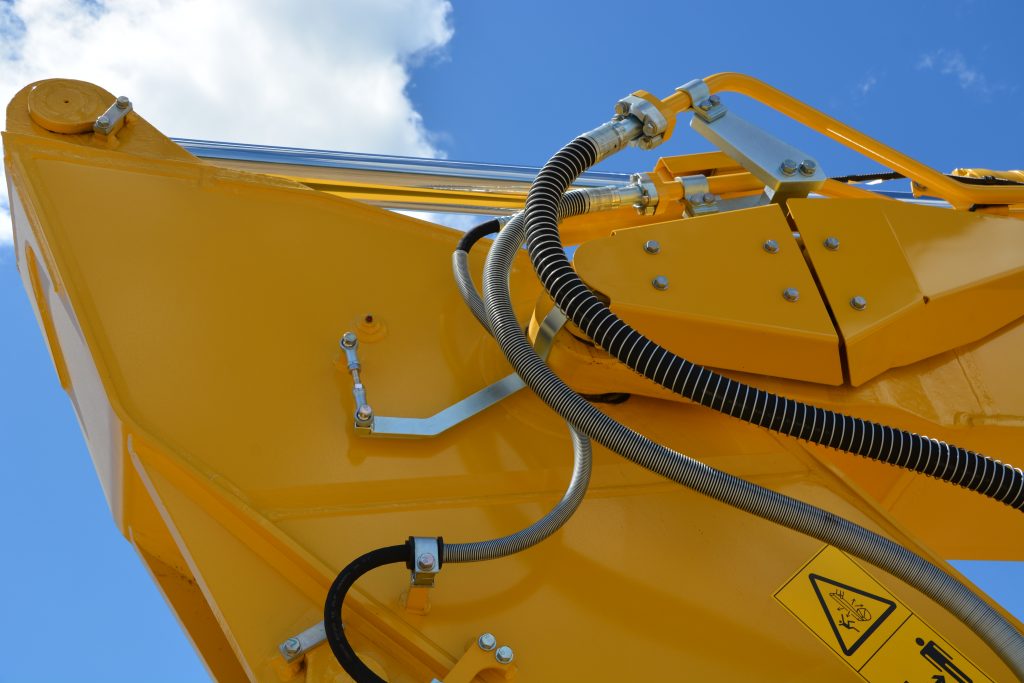 Mounted discreetly up on the handrails on either side of the machine are the 2 x GNSS antennae, which are of a clip-on design. I like this idea a lot, there is no need for the big mounting poles that we see on other machines with a retro-fit solution and Komatsu have designed them so that the operator can easily fit and remove them at the end of the shift for safe keeping.
Mounted discreetly up on the handrails on either side of the machine are the 2 x GNSS antennae, which are of a clip-on design. I like this idea a lot, there is no need for the big mounting poles that we see on other machines with a retro-fit solution and Komatsu have designed them so that the operator can easily fit and remove them at the end of the shift for safe keeping.
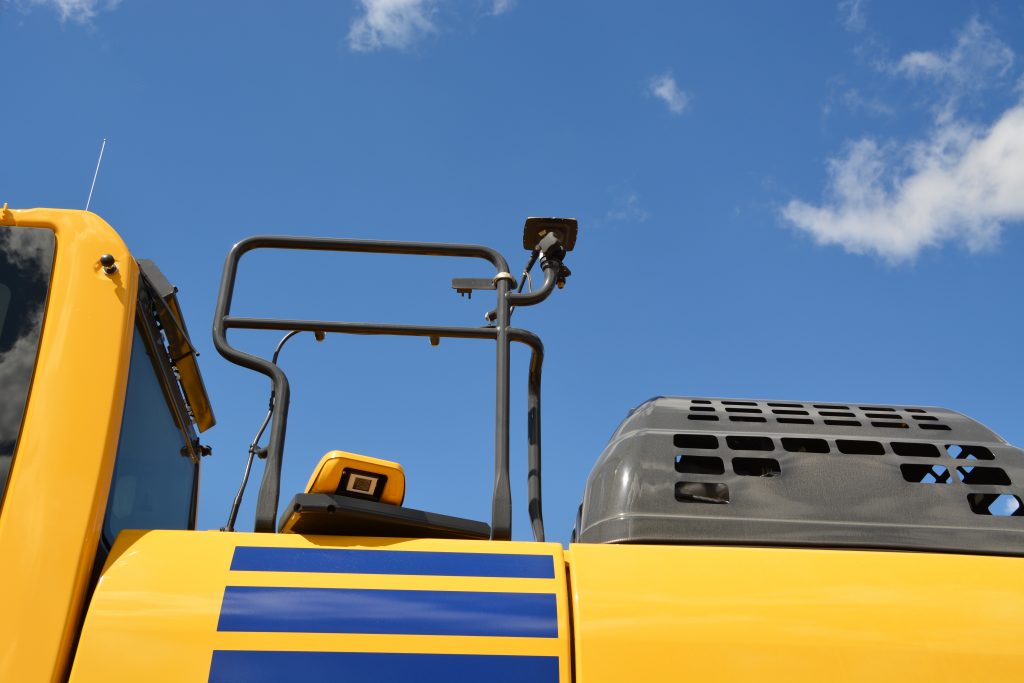 The biggest difference on the IMC machines is in the cab and as we saw previously back in 2014 on the 21-tonne version, the PC360LCi also features a 12.1inch full colour touch screen monitor, which is a focal point in the cab for the operator. This iPad sized screen, which is situated up above the machines standard monitor, provides all the site design detail, mapping and 3D representation of the machine with that real time movement right there on the screen.
The biggest difference on the IMC machines is in the cab and as we saw previously back in 2014 on the 21-tonne version, the PC360LCi also features a 12.1inch full colour touch screen monitor, which is a focal point in the cab for the operator. This iPad sized screen, which is situated up above the machines standard monitor, provides all the site design detail, mapping and 3D representation of the machine with that real time movement right there on the screen.
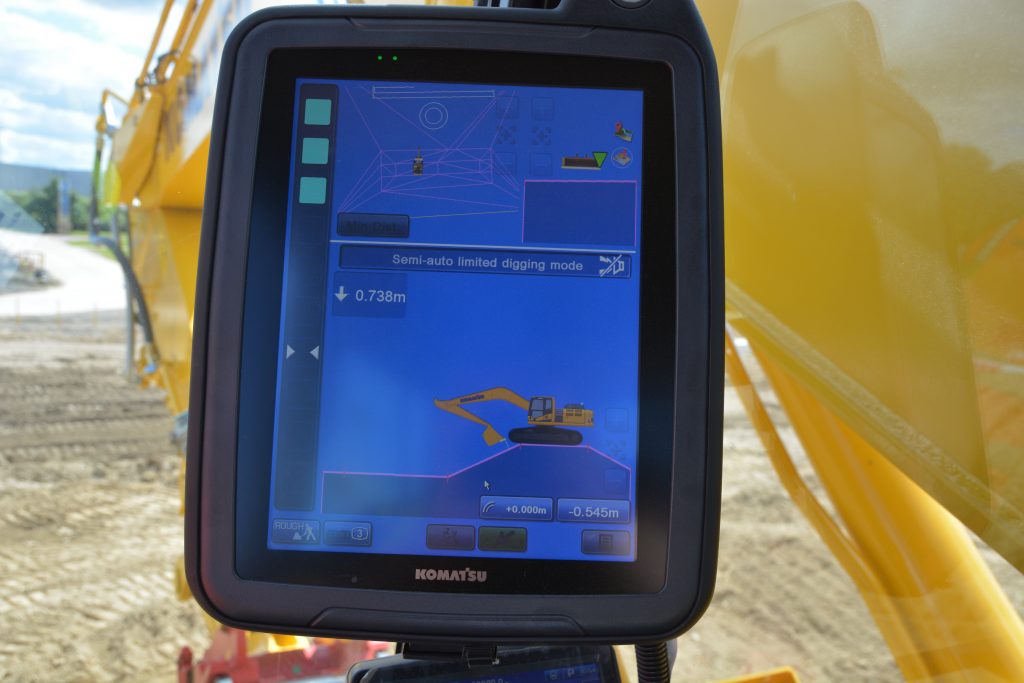 Operators can choose Manual mode during which time the machine operates and functions just like a standard excavator, relying on the operator’s free hand skills, a great operation when bulking out for instance. On selection of the Semi-Auto mode the machine will dig to the parameters laid down by the site design drawings, that have been punched into the system, in this mode it will not allow the operator to over-dig thanks in part to the Auto Stop Control, which will not allow you to put down the boom any further than the site design surface.
When cutting batters and slopes, the IMC Auto Grade Assist feature automatically lifts the boom as the operator pulls in the dipper arm, while cutting the desired angle, once the bucket is full the operator simply crowds the bucket and takes back control to slew and discharge the load before returning to the cut. In most instances it would be the preferred method to pull a batter uphill, but this system can work equally as well either way, both pulling up or cutting down by locating the machine down at the toe of the batter.
Operators can choose Manual mode during which time the machine operates and functions just like a standard excavator, relying on the operator’s free hand skills, a great operation when bulking out for instance. On selection of the Semi-Auto mode the machine will dig to the parameters laid down by the site design drawings, that have been punched into the system, in this mode it will not allow the operator to over-dig thanks in part to the Auto Stop Control, which will not allow you to put down the boom any further than the site design surface.
When cutting batters and slopes, the IMC Auto Grade Assist feature automatically lifts the boom as the operator pulls in the dipper arm, while cutting the desired angle, once the bucket is full the operator simply crowds the bucket and takes back control to slew and discharge the load before returning to the cut. In most instances it would be the preferred method to pull a batter uphill, but this system can work equally as well either way, both pulling up or cutting down by locating the machine down at the toe of the batter.
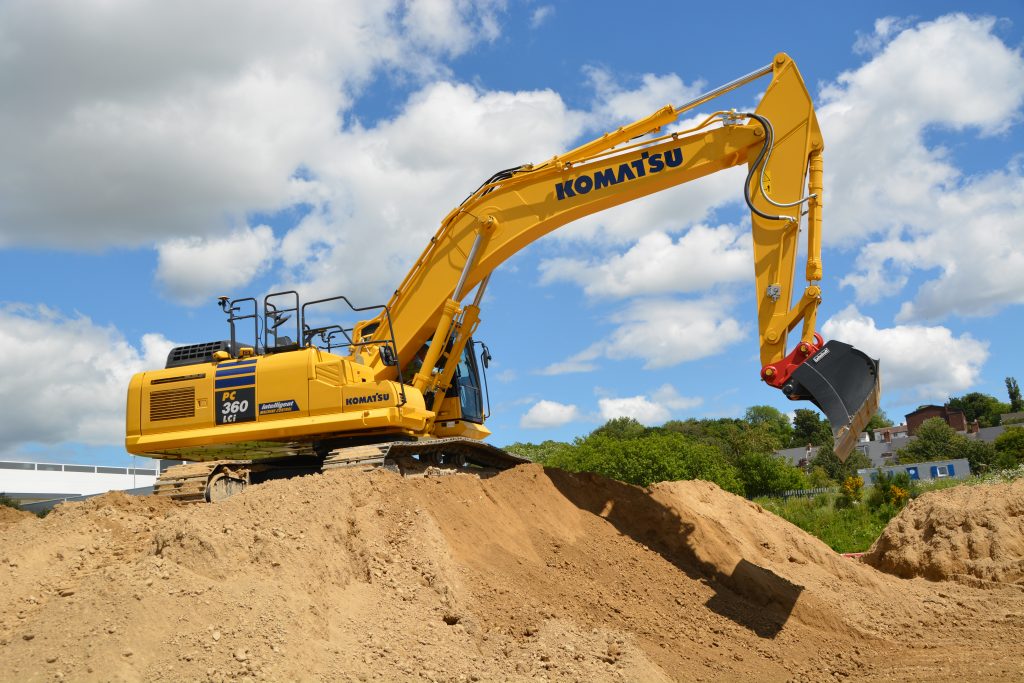 The benefits of this system are many fold, for the younger operators or the so-called Play Station generation, who are generally well versed in using tablets and smart phones, using this technology they will quickly gain confidence to be able to work to the site design and to achieve the grades first time without any costly over-digging scenarios, while for experienced operators we will see a reduction in fatigue, keeping the man in the seat fresh and more importantly productive, while we can also expect to see a reduction in fuel consumption by working smarter.
The PC360LCi-11 is ultimately aimed at the large infrastructure project sector and with its on-board technology will be seen as a machine for all tasks from bulk excavation and earthmoving to truck loading and finesse work like fine grading a real machine for all seasons!
The benefits of this system are many fold, for the younger operators or the so-called Play Station generation, who are generally well versed in using tablets and smart phones, using this technology they will quickly gain confidence to be able to work to the site design and to achieve the grades first time without any costly over-digging scenarios, while for experienced operators we will see a reduction in fatigue, keeping the man in the seat fresh and more importantly productive, while we can also expect to see a reduction in fuel consumption by working smarter.
The PC360LCi-11 is ultimately aimed at the large infrastructure project sector and with its on-board technology will be seen as a machine for all tasks from bulk excavation and earthmoving to truck loading and finesse work like fine grading a real machine for all seasons!
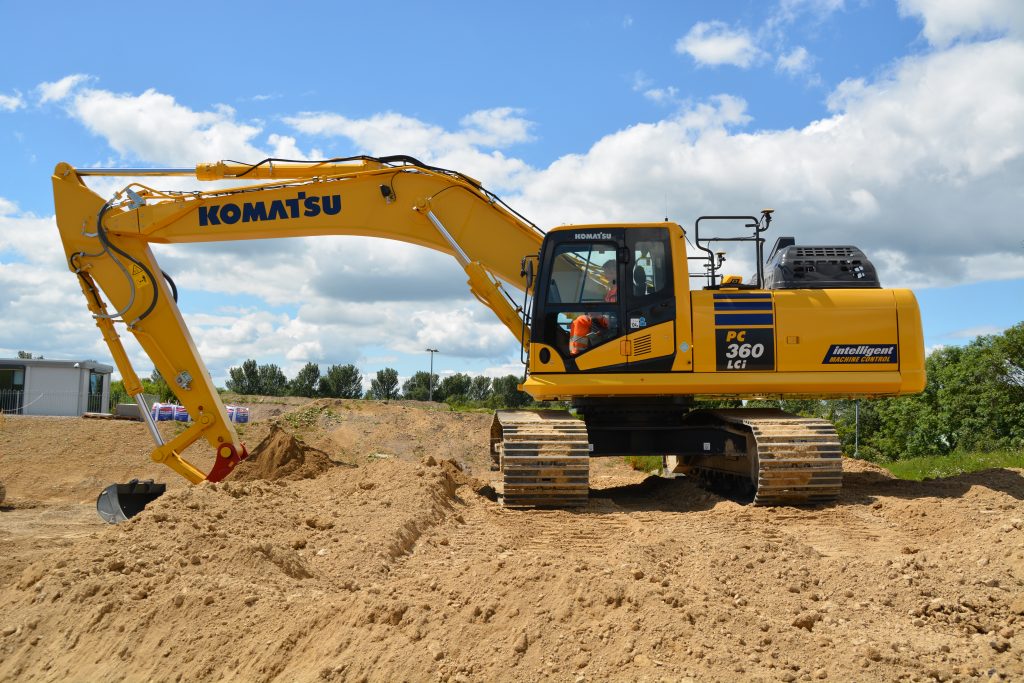 Having watched Rob using the machine on the demo plot adjacent to the Komatsu UK factory, I was then invited to have a go for myself. For this demonstration the machine was fitted with a Lehnhoff manual quick coupler, unusual on this size machine but it served a purpose. A Lehnhoff grading bucket was also fitted and I must say, what a quality product it was too.
So once again in the seat of an LCi machine, I was given a brief tutorial on the basics and away I went. A quick tug on the levers and the glorious sound of the big Komatsu engine filled the air. Rob had previously entered in a slope angle cut for me so I set about trimming up the gravelly material on the demo plot. Initially the cut was heavy so I set the machine to manual to get rid of the bulk of the material, not that I needed to of course, but I felt comfortable doing it that way. Even without any machine control on the big Komatsu was very smooth to operate.
Having watched Rob using the machine on the demo plot adjacent to the Komatsu UK factory, I was then invited to have a go for myself. For this demonstration the machine was fitted with a Lehnhoff manual quick coupler, unusual on this size machine but it served a purpose. A Lehnhoff grading bucket was also fitted and I must say, what a quality product it was too.
So once again in the seat of an LCi machine, I was given a brief tutorial on the basics and away I went. A quick tug on the levers and the glorious sound of the big Komatsu engine filled the air. Rob had previously entered in a slope angle cut for me so I set about trimming up the gravelly material on the demo plot. Initially the cut was heavy so I set the machine to manual to get rid of the bulk of the material, not that I needed to of course, but I felt comfortable doing it that way. Even without any machine control on the big Komatsu was very smooth to operate.
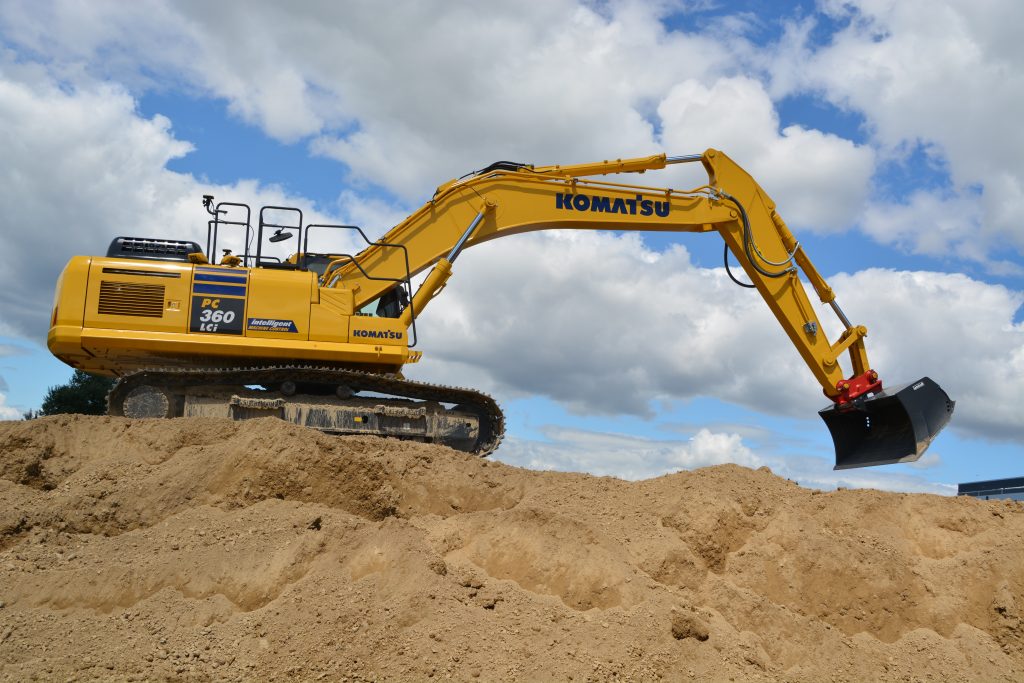 If I had to be critical, I found the dipper in and out stroke a little slow, but I’m sure that could be tweaked up a bit if needed. As I got closer to the site design on the screen, I opted to select the Semi-Auto limited digging mode, this flashes up on the screen and an audible signal lets me know its been selected. Slewing back to the cut, I lower the bucket and once it’s reaches the design cut the auto stop feature prevents me from lowering it anymore, even if I aggressively try to drop it, the system overrides my attempts to lower. At this point I pull on the left hand joystick to bring in the dipper, while doing so the boom starts to lift on its own without any input from me, to successfully achieve the required cut, as the dipper reached the top of the batter I regain full control and curl the bucket.
If I had to be critical, I found the dipper in and out stroke a little slow, but I’m sure that could be tweaked up a bit if needed. As I got closer to the site design on the screen, I opted to select the Semi-Auto limited digging mode, this flashes up on the screen and an audible signal lets me know its been selected. Slewing back to the cut, I lower the bucket and once it’s reaches the design cut the auto stop feature prevents me from lowering it anymore, even if I aggressively try to drop it, the system overrides my attempts to lower. At this point I pull on the left hand joystick to bring in the dipper, while doing so the boom starts to lift on its own without any input from me, to successfully achieve the required cut, as the dipper reached the top of the batter I regain full control and curl the bucket.
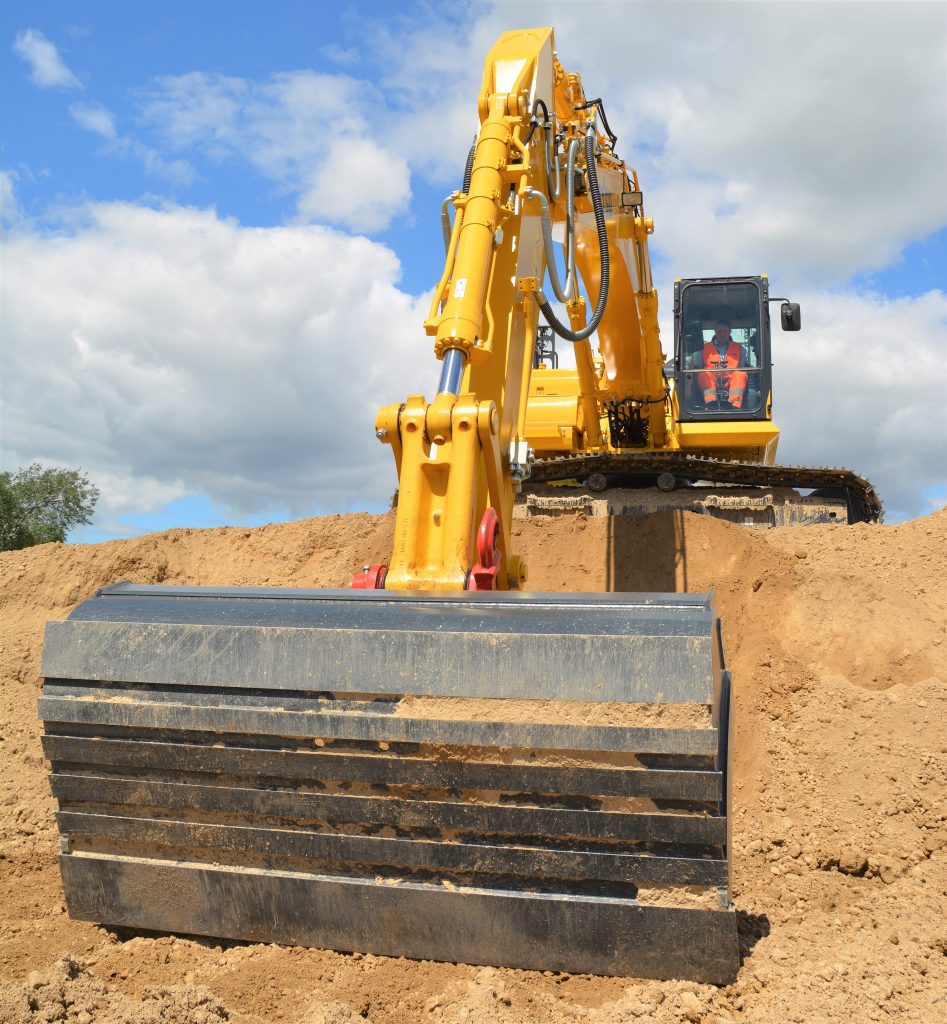 It really is mind blowing stuff and takes virtually all of the guess work out of the job, no need for old school batter rails or a “slasher” man running up and down with a string line like we used to back in the day! This is state of the art modern day excavation at its best.
As a challenge Rob asked me to trim up manually to see how it compared, now by my own admission I’m very much out of practice these days, so it came as no surprise, that it took me a couple of passes at least to achieve the proper grade. It really brought it home to me as to how beneficial this Intelligent Machine Control can be in the right hands. It would take a little while to get used to the technology, but once mastered who wouldn’t want one of these machines!
Checkout our video clip taken on the day of our visit.
I would like to take this opportunity to thank Grant Young, John Lawson and Robert Macintyre of Komatsu UK for their assistance on the day of our visit.
It really is mind blowing stuff and takes virtually all of the guess work out of the job, no need for old school batter rails or a “slasher” man running up and down with a string line like we used to back in the day! This is state of the art modern day excavation at its best.
As a challenge Rob asked me to trim up manually to see how it compared, now by my own admission I’m very much out of practice these days, so it came as no surprise, that it took me a couple of passes at least to achieve the proper grade. It really brought it home to me as to how beneficial this Intelligent Machine Control can be in the right hands. It would take a little while to get used to the technology, but once mastered who wouldn’t want one of these machines!
Checkout our video clip taken on the day of our visit.
I would like to take this opportunity to thank Grant Young, John Lawson and Robert Macintyre of Komatsu UK for their assistance on the day of our visit.